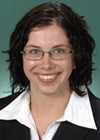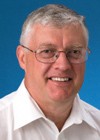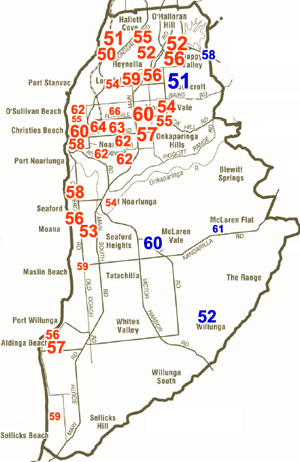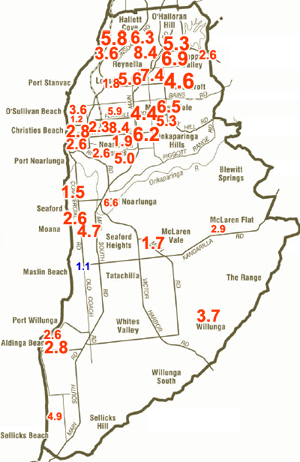Electoral Form Guide: Kingston
Electorate: Kingston
Margin: Labor 4.4%
Location: Outer Southern Adelaide, South Australia
In a nutshell: A volatile mortgage belt seat that changed hands in 1996, 1998, 2004 and 2007, Kingston fell on the latter occasion with a 4.5 per cent swing that was on the low side by South Australian standards. First-term Labor member Amanda Rishworth will defend the seat from police inspector Chris Zanker, the tardily preselected Liberal candidate.
The candidates
|
|
RON BAKER
|
|
|
Two-party vote map
|
Swing % map |
Electorate analysis: The southern Adelaide seat of Kingston was one of three seats in the city to fall to Labor on the back of the 6.8 per cent statewide swing in 2007, along with Makin in the city’s east and Wakefield in the outer north. The electorate has been extremely sensitive to the tides of electorate fortune since it was created with the enlargement of parliament in 1949, having maintained its mortgage belt orientation by shifting southwards as the city expanded. In the early days it was based around Glenelg and Brighton, its then southernmost suburb of Hallett Cove being the only area still in the electorate today. Glenelg was hived off to since-abolished Hawker in 1984, and Brighton went to Boothby in 1993. Kingston now extends from Hallett Cove and industrial Lonsdale south to the outermost beachside suburbs of Moana and Port Willunga, and to the McLaren Vale wine-growing district further inland. Most of the population is in the north of the electorate, around Noarlunga, Reynella and Morphett Vale. This area is divided between a traditionally Liberal-leaning north-east and a solidly Labor south-west. Labor is also strong in the thin strip of coastal suburbs further south, which also record strong support for the Greens, while the McLaren Vale area provides the Liberals with their two strongest booths.
Kingston had a notional Labor margin of 6.8 per cent upon its creation, but was swept up in the landslide that put the Menzies government in power in 1949. Pat Galvin gained the seat for Labor in 1951, and was re-elected with varying margins until 1966. It was then caught up in the statewide convulsions of 1966 and 1969, which produced double-digit swings first to Liberal and then to Labor in both Kingston and South Australia as a whole. The Liberals thus held the seat for one term before it returned emphatically to Labor. Kingston subsequently changed hands with the next three changes of government, being held by Grant Chapman during the Fraser years (he returned as a Senator in 1987), and by Gordon Bilney from the election to Hawke government until his defeat in 1996 by Liberal candidate Susan Jeanes following a relatively mild 3.4 per cent swing. Jeanes had too little fat on her margin to withstand the GST backlash of 1998, when Labor’s David Cox prevailed by 763 votes on the back of a 2.5 per cent swing.
With South Australia’s representation cut from 12 seats to 11 at the 2004 election, Kingston was made to absorb the McLaren Vale area, giving the Liberals what proved to be a decisive 1.1 per cent boost. Requiring a further 1.4 per cent swing to topple Cox, Liberal candidate Kym Richardson achieved that and little more, prevailing over Cox by 119 votes. A former police officer, SANFL Aussie Rules player and sports manager (whose clients included AFL star Byron Pickett and test cricketer Jason Gillespie), Richardson’s buffer was nothing like enough to protect him from what by South Australian standards was a mild 4.5 per cent swing. The incoming Labor member was Amanda Rishworth, a psychologist and former organiser for the Right faction Shop Distributive and Allied Employees Association who won preselection unopposed as part of a factional arrangement.
Kym Richardson has expressed interest in returning to the seat, and was anointed by state Opposition Leader Martin Hamilton-Smith as candidate for the corresponding state seat of Mawson in early 2008. However, he was forced to withdraw late in the year when it emerged he was the subject of a police investigation that would see charges of attempting to pervert the course of justice laid against him the following July. It was alleged that Richardson, himself a former police officer, had sought to influence an investigation into an assault involving his son in 2005 by impersonating a police officer over the phone while in his Canberra office. The charge was unable to proceed due to a six month statute of limitations, and he again expressed interest in running in Kingston, potentially as an independent. The Liberal nomination eventually went to Chris Zanker, a senior inspector with the South Australian police, who was preselected in the first week of the campaign.
 Late in the first week of the campaign, The Advertiser published a survey of 605 Kingston voters which showed Labor with a frankly unbelievable two-party lead of 67-33. On the primary vote, Rishworth led Liberal candidate Chris Zanker 58 per cent to 25 per cent, with the Greens on 9 per cent and Family First on 6 per cent. Respondents favoured Julia Gillard over Tony Abbott by 68 per cent to 22 per cent, which panned out to 73 per cent to 17 per cent among women. Labor’s primary vote lead was 61 per cent to 24 per cent among women and 55 per cent to 27 per cent among men. Labor was rated best to handle asylum seekers by 44 per cent against 34 per cent for the Liberals. While The Advertiser’s Mark Kenny candidly acknowledges the likelihood the poll was a “rogue”, he also reported “party research shows that none of the previously marginal Labor seats is in danger of falling”. In the second last week of the campaign the seat was one of four South Australian marginals covered by a Galaxy survey of 800 respondents, and it showed no swing across the four. The JWS Research-Telereach poll conducted during the final weekend of the campaign, covering 400 respondents in the electorate with a margin of error of about 5 per cent, had Labor leading 58.6-41.4.
Late in the first week of the campaign, The Advertiser published a survey of 605 Kingston voters which showed Labor with a frankly unbelievable two-party lead of 67-33. On the primary vote, Rishworth led Liberal candidate Chris Zanker 58 per cent to 25 per cent, with the Greens on 9 per cent and Family First on 6 per cent. Respondents favoured Julia Gillard over Tony Abbott by 68 per cent to 22 per cent, which panned out to 73 per cent to 17 per cent among women. Labor’s primary vote lead was 61 per cent to 24 per cent among women and 55 per cent to 27 per cent among men. Labor was rated best to handle asylum seekers by 44 per cent against 34 per cent for the Liberals. While The Advertiser’s Mark Kenny candidly acknowledges the likelihood the poll was a “rogue”, he also reported “party research shows that none of the previously marginal Labor seats is in danger of falling”. In the second last week of the campaign the seat was one of four South Australian marginals covered by a Galaxy survey of 800 respondents, and it showed no swing across the four. The JWS Research-Telereach poll conducted during the final weekend of the campaign, covering 400 respondents in the electorate with a margin of error of about 5 per cent, had Labor leading 58.6-41.4.
Analysis written by William Bowe. Read Bowe’s blog, The Poll Bludger.





